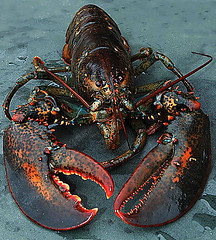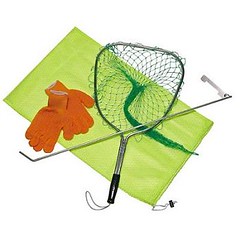Last week I was in the Florida Keys with my parents, boating and lobster diving with various relatives and friends. Since most people I talk to are a little bemused about what’s involved in Florida lobster diving, here’s an overview.
When I talk about lobster, most people picture this:

Maine lobster
But I’m talking about this:

Florida spiny lobster
Lobster of the southern Atlantic do NOT have claws. But they have sharp legs, feelers, and spines, so always wear gloves when handling them. They’re referred to as spiny lobster, or rock lobster, and they live under rocks (coral or otherwise) or inside holes in the sea floor. Your best chance at finding a good number of them is to look for a coral head offshore. My dad and relatives have been diving for lobster all their lives and can spot coral heads at a distance, but if you don’t have much experience, it can be difficult to identify a spot. My family has caught lobster in as shallow as 3-4 feet and as deep as about 20 feet. That time, I watched my dad stick his entire arm under a grassy shelf in the sea floor, and shake the shelf so hard that all kinds of stuff started breaking off. I advise against this, both for personal safety (eels and things live in these holes, too!!) and for the sake of nature!
To catch lobster, you need the following:

• A small net with a handle
• A tickle stick, preferably with a measuring gauge attached
• Diving gloves
• A cooler to put the lobster in, if your boat doesn’t have a holding tank
• Plus a mask, snorkel, and fins like you would typically use for snorkeling.
Sometimes you can catch a lobster that’s swimming around in the sea grass, but you’ll probably need to coax them out from under their rock. When you’ve extracted the lobster, dive down with the net in one hand and the tickle stick in the other. Hold the net behind the lobster, and tap it between its feelers with the tickle stick. They can only swim backward, so it should swim right into the net. Then measure it – a keeper has to be at least three inches long from the spot between its eyes to the bottom of its front shell (which is called a carapace).
Lobstering is unpredictable. You never know how many lobster you might find at one spot. On our first day this time, we visited about 15 holes and it took most of the day, but we also had a lot of people. The Florida season runs from August to March, and the limit is 6 lobster per person per day (after purchase of a saltwater fishing and lobster license). You can find a lot more information at floridalobstering.com.
I’m typically more of a spectator on our dive trips, but this time I caught a few lobster myself! It was exciting. However, I don’t participate in the cleaning or cooking of the lobster. They’re usually still alive when you start cleaning them up, and I CANNOT deliver the death knell to a living creature (other than the occasional bug, and even then I don’t like it). But I’ll eat it happily. I know that’s very inconsistent of me, but I’m okay with it.
Here are a few lobstering pictures from last week!

Thousands of miles southeast of Dutch Harbor…
42 the first day, 48 the second day. Another great dive in the books!



Wow, that’s really neat how you catch them! Though I still think they’re mighty creepy looking!
This was fascinating! Thanks for writing it up!
[…] lobster diving is a big question mark to you, check out my informational post from a few years back. Good now? Okay. Here’s a very typical day of lobstering with my […]
[…] that precedes it by a few weeks. (If you’re unfamiliar with Florida lobstering, check out my brief overview from a few years ago.) This year our crew consisted of me, my parents and brother, both of my paternal uncles and aunts, […]